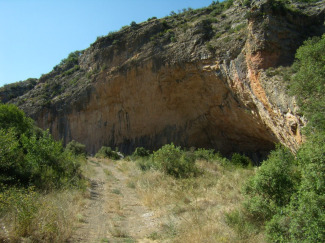When did the first "modern" human beings appear in the Iberian Peninsula?

The work, published in the "Journal of Human Evolution", was coordinated by Rafael Mora, Professor of Prehistory and Director of the CEPAP-UAB. Jorge Martínez-Moreno, a researcher at the CEPAP-UAB and Ignacio de la Torre, Lecturer Institute of Archaeology of University College, London also took part in the project.
Cova Gran is a large shelter discovered in 2002, located in the area of Les Avellanes-Santa Linya -La Noguera- and is one of the rare European archaeological sites to enable the study of what is known in Paleoanthropology as "transitions" or critical phases in which transformations and remodelling that are essential for reconstructing the history of our species can be detected.
The investigators from the UAB have worked on an area of 60 metres squared, excavating a large area which has enabled them to reconstruct the way in which the people who inhabited the shelter lived. This system of working is not usual in archaeology since excavations are generally restricted to smaller earth movements. They have been able to recover archaeological materials from the Middle Palaeolithic attributable to Homo neanderthalensis, and from the Upper Palaeolithic, which corresponds to Homo sapiens, separated by sterile strata of sediment which allows their differentiation.
The exceptional conditions of conservation of these archaeological remains, which have remained unaffected by biological and geological changes, have meant that the materials used by each of these species has been conserved without the need for significant earth movements, contrary to that which has been indicated in other archaeological sites. This detailed analysis of the tool remains recovered allows major differences to be observed in the way in which they were made, implying that they were made by different species.
This is something that has also been recognised in other sites in Western Europe, and it goes to strengthen the hypothesis that the two species neither lived together nor interacted with each other, although they may have lived in the same geographical area during the period from 40,000 to 30,000 years, which is generally referred to as the Middle/Upper Palaeolithic "transition".
Cova Gran was occupied successively by Neanderthals and "modern" humans in small groups of 15 to 20 people with a similar lifestyle: hunting, gathering, making tools for their daily activities and obtaining and processing food for which the use of fire was essential. In spite of this, each species used very different techniques and primary materials.
Among the remains found that are attributable to Homo sapiens are several perforated sea snail shells, generally considered to be an indicator of the distribution of the species throughout Africa, the Middle East and Western Europe. They also denote the existence of a symbolic language and cognitive capacities for which there is no evidence during the Middle Palaeolithic These objects indicate that Homo sapiens travelled widely across lands from the Mediterranean coast to the Pyrenean foothills, a distance of over 150 kilometres, although the researchers do not rule out the existence of social networks which would connect groups separated by large distances and through which these objects would circulate. If this were the case, the ornaments would be a key symbolic element in the social structure of this people and a clue to their identity.
The work also offers new data about the period in which the first representatives of the so-called "modern humans" appeared in the Iberian Peninsula and the extinction of the Neanderthals, a question that has generated some heated debate within the area of Paleoanthropology. The Carbon 14 dated samples in Cova Gran make references to a period of between 34,000 and 32,000 years in which this biological replacement in the Western Mediterranean can be located in time.
Notwithstanding, the study also discusses the validity of C14, the method habitually used to date archaeological remains from that period. Although C14 is a vital tool for dating archaeological sites, one conclusion to emerge from the study is that the period between 40 and 30 thousand years cannot be considered as "historic" years. This observation has rekindled the controversy that has existed for some time in archaeology about whether C14 is a totally reliable timepiece. The radioactive isotope regularly disintegrates but from 30,000 years its presence in samples is residual and, in many cases, the samples have been exposed to processes of change that are difficult to identify. The researchers argue that much of the data that is usually obtained in studies of this period may correspond to samples that have been contaminated or have been treated in laboratories using methods that have failed to detect this type of problem. Currently improvements are being developed which it is hoped will eliminate this uncertainty.
The Cova Gran site covers a total surface area of 2,500 metres squared and contains an important archaeological heritage. Future excavations will enable more profound investigations into how modern humans settled in the Iberian Peninsular and their evolution over the last 40,000 years.
References
"The Middle-to-Upper Palaeolithic transition in Cova Gran (Catalunya, Spain) and the extinction of Neanderthals in the Iberian Peninsula". Martínez-Moreno, J. Mora, R. De la Torre, I. Journal of Human Evolution 58 (2010). 211.226.

